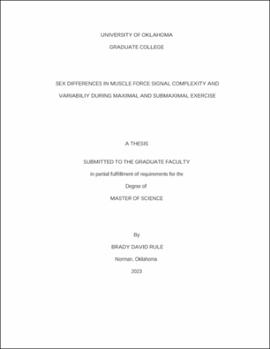| dc.contributor.advisor | Larson, Rebecca | |
| dc.contributor.author | Rule, Brady | |
| dc.date.accessioned | 2023-05-15T19:40:47Z | |
| dc.date.available | 2023-05-15T19:40:47Z | |
| dc.date.issued | 2023-05-12 | |
| dc.identifier.uri | https://hdl.handle.net/11244/337692 | |
| dc.description.abstract | Sex differences have been a topic of interest in exercise physiology as of late, especially the possibility of a sex-dependent fatigue mechanism. Signal complexity has the potential to provide a better picture of fatigue by examining the behavior of a signal produced throughout a fatiguing task. Complexity measures the self-similarity and regularity of a signal and is associated with a system’s ability to respond to a change in condition. PURPOSE: To determine if there are sex differences in variability and complexity of a force signal before and/or after maximal and or/submaximal exercise. METHODS: 16 healthy untrained individuals (9 females, 7 males) completed a maximal and submaximal isometric resistance exercise test using a handmade dynamometer. The maximal exercise test consisted of a 5-minute all-out test with 30 maximal effort isometric knee extensions at a 60% duty cycle (6s contraction, 4s rest). The submaximal exercise consisted of a submaximal test performed at 50% of their maximal voluntary contraction until task failure at a 60% duty cycle. Complexity and variability measures were calculated from the first and last three contractions. Performance measures included pre and post MVC, blood lactate, rating of perceived exertion (RPE), Time-to-Exhaustion (TTE), and force decrement. RESULTS: There were significant sex differences found in complexity and performance measures. Males experienced greater fatigue and levels of complexity after maximal and submaximal exercise. CONCLUSION: Further research is needed to determine the significance and applicability of complexity measures in exercise physiology. However, it appears low complexity in females is associated with increased fatigue resistance in a healthy untrained population after maximal and submaximal isometric resistant exercise. | en_US |
| dc.language | en | en_US |
| dc.rights | Attribution-NoDerivatives 4.0 International | * |
| dc.rights.uri | https://creativecommons.org/licenses/by-nd/4.0/ | * |
| dc.subject | Sex Differences | en_US |
| dc.subject | Complexity | en_US |
| dc.subject | Fatigue | en_US |
| dc.subject | Exercise | en_US |
| dc.title | Sex differences in muscle force signal complexity and variability during maximal and submaximal exercise | en_US |
| dc.contributor.committeeMember | Black, Christopher | |
| dc.contributor.committeeMember | Larson, Daniel | |
| dc.date.manuscript | 2023-05-05 | |
| dc.thesis.degree | Master of Science | en_US |
| ou.group | Dodge Family College of Arts and Sciences::Department of Health and Exercise Science | en_US |
| shareok.orcid | 0009-0002-7995-1900 | en_US |

